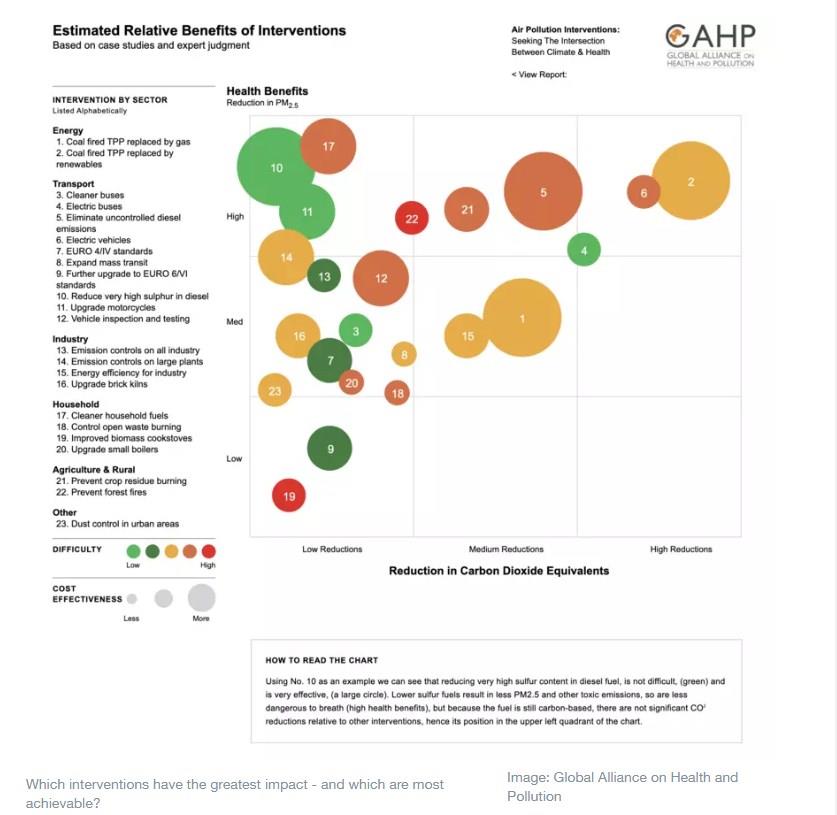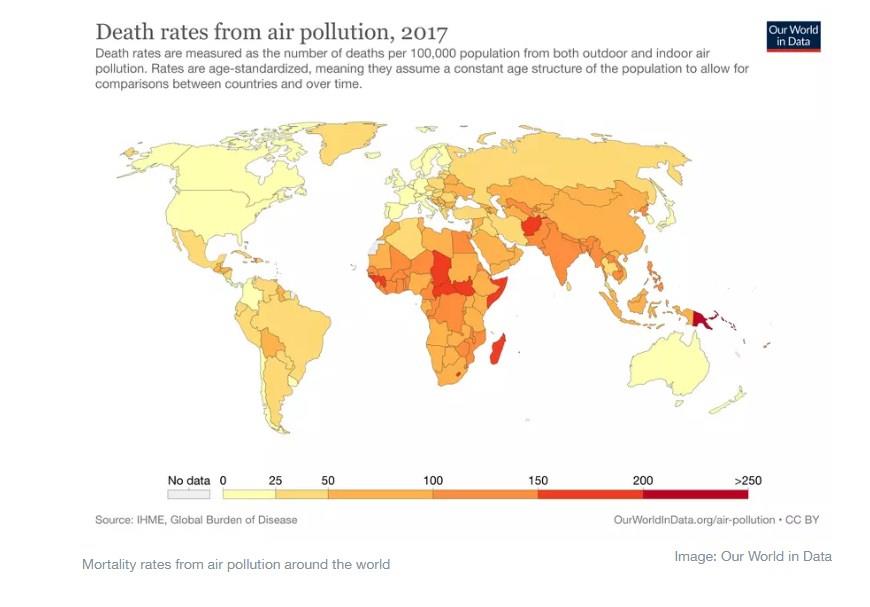by Richard Fuller*
When we look at air pollution and climate change, we see two dire situations:
1. People, especially in low- and middle-income countries (LMIC), are becoming ill and dying prematurely because of the poor quality of the air they breathe. Air pollution is linked to an estimated 4.2 million premature deaths a year, according to the World Health Organization. When indoor air quality is considered, that number rises by an estimated 2.9 to 4.3 million deaths a year, according to The Lancet Commission.
2. Glacial ice is melting, droughts are becoming more prolonged, extreme weather events are more common, and cities around the world are reporting record-breaking heat, all against a backdrop of predictions from the International Panel on Climate Change of temperature increases between 2.5?C and 10?C over the next century.
For years, the prevailing wisdom has argued that the same adverse conditions that propel climate change also are responsible for air pollution, and that by correcting one problem we can also solve the other.
Unfortunately, it’s not as simple as that. Some interventions that can massively improve air quality and the health of people in affected communities, such as using lower-sulphur diesel fuel, have little or no impact on climate change. Others produce benefits for the climate but do not significantly impact health. And still other popular and often costly interventions do little to improve air quality or slow the pace of climate change.
With our partners – AirQualityAsia, The Schiller Institute for Integrated Science and Society at Boston College, and with support from the Clean Air Fund – we set out to identify the most successful and practical actions that can improve health by reducing air pollution and impact climate change. Because very little analytical data is available about outcomes for specific interventions, our researchers and consultants went directly to those deeply involved in air pollution projects around the world to learn what had worked, what had not, and why.
The result of these efforts – a new report entitled Air Pollution Interventions: Seeking the Intersection between Climate and Health – is intended to help governments and policy-makers identify and implement the most effective interventions for their communities and particular situations.

When we talk about adverse health effects from air pollution, our report focuses primarily on particulate matter 2.5 microns and smaller in size (PM2.5), which are largely produced by carbon burning. These microscopic particles, less than one-thirtieth the width of a human air, pass through the lungs and into the bloodstream where they are carried throughout the body to cause damage to respiratory, cardiovascular, and other systems, and according to the Institute for Health Metrics and Evaluation account for more than 85% of air pollution-related mortality.
With regard to climate change, the report mainly looks at activities that increase atmospheric concentrations of carbon dioxide and black carbon.
PM2.5, black carbon and CO2 are largely the byproducts of carbon burning. The three primary sources are:
1. Energy generation from coal and natural gas
2. Public and private transportation of people and goods using diesel or gasoline
3. Open fires, mostly crop burning and forest fires, but also uncontrolled waste incineration
Coal-fired power plants are the granddaddies of air pollution and climate change – and we’ve known this for some time. Likewise, the single most effective action governments can take to improve air quality and to impact climate change is to phase out the use of coal and other fossil fuels, such as tar and lignite, for power generation.
If you take a big coal-fired power plant in the middle of a city and replace it with renewable energy, that’s huge. Converting coal-fired power plants to natural gas or installing scrubbers reduces PM2.5 emissions – and so benefits health – but the carbon-burning power plants are still producing CO2 and climate-changing emissions. While moving that coal-fired power plant outside the city may be politically popular with millions of city dwellers (less so, perhaps, with people near the new plant), the action is costly and does nothing to benefit health or climate change.

Other significant interventions that improve both health by reducing PM2.5 and impact climate change by reducing CO2 emissions include:
• Replacing diesel and gasoline-powered vehicles with electric vehicles. Shenzhen, China, for instance, has switched from diesel-powered public transportation to an electric bus fleet with an expected 48% reduction in CO2 emissions and significant reductions in particulate matter.
• Eliminating uncontrolled diesel emissions. Studies have found that reducing vehicle fleet levels from the equivalent of Euro I to Euro IV can reduce fleet emissions by about 80% and moving up to Euro V standards further reduces the remaining emissions by 80%.
• Preventing crop burning. Specific technologies and education can improve outcomes for farmers without burning – creating win-win situations. Education and support for agricultural extension programmes in developing countries are key to their success. Poland, for example, has largely phased out the practice of burning the stubble left after the wheat harvest. Government initiatives in Delhi to combat crop burning, a significant source of air pollution, include awareness and capacity building, technological interventions, and subsidies for farmers to purchase straw management machines. Still, the twice-annual traditional crop burning contributes significantly to Delhi’s notorious haze.
Our team considered 22 interventions with dozens of supporting case studies with the goal of helping governments and policy-makers determine which interventions may be most practical and beneficial for their particular problems.
We know that exposure to PM2.5 makes people more susceptible to respiratory illnesses; preliminary studies and anecdotal reporting early in the COVID-19 pandemic suggest that infection rates initially were higher and illnesses more severe in cities with poorer air quality. We also know that increasingly the citizenry is demanding that its leaders take swift and sure action to combat air pollution, as underscored by a recent survey by the Clean Air Fund of people in the UK, Bulgaria, India, Nigeria and Poland. As The New York Times reports, the survey, which was conducted during the pandemic between 22 May 22 and 2 June, found overwhelming support for stricter air quality regulations and better enforcement of existing rules. In Nigeria and India, for instance, 90% of those surveyed said they wanted improved air quality.
The most important step for municipal and national agencies is to raise their level of ambition in achieving their air quality and climate objectives. The overall aim must be an economy where development is uncoupled from resource use and energy provision is de-carbonized. Short-term actions can then be selected and implemented within that framework.
The solutions exist – and with technical support, strategic funding, and public and private initiatives, we can successfully improve public health and combat climate change.
*President, Pure Earth
**first published in: www.weforum.org




 By: N. Peter Kramer
By: N. Peter Kramer

